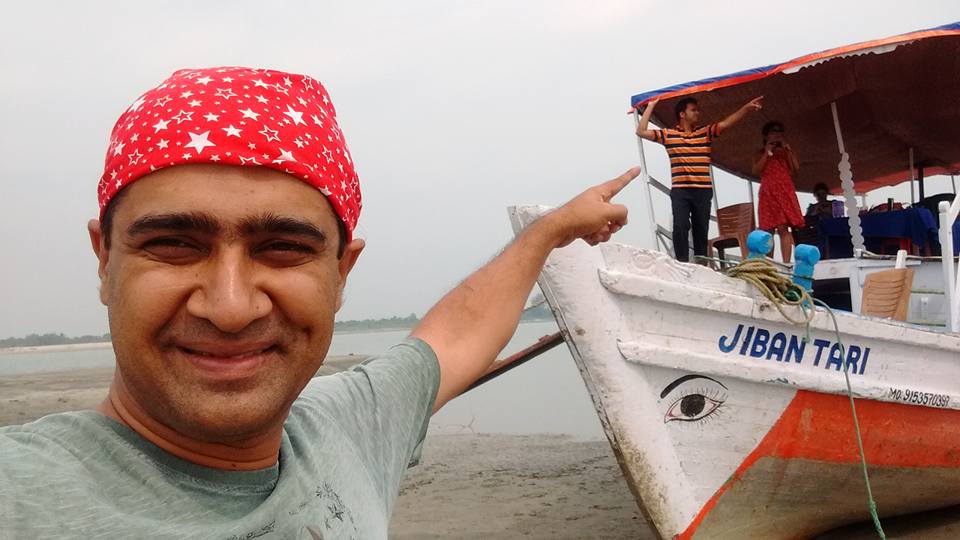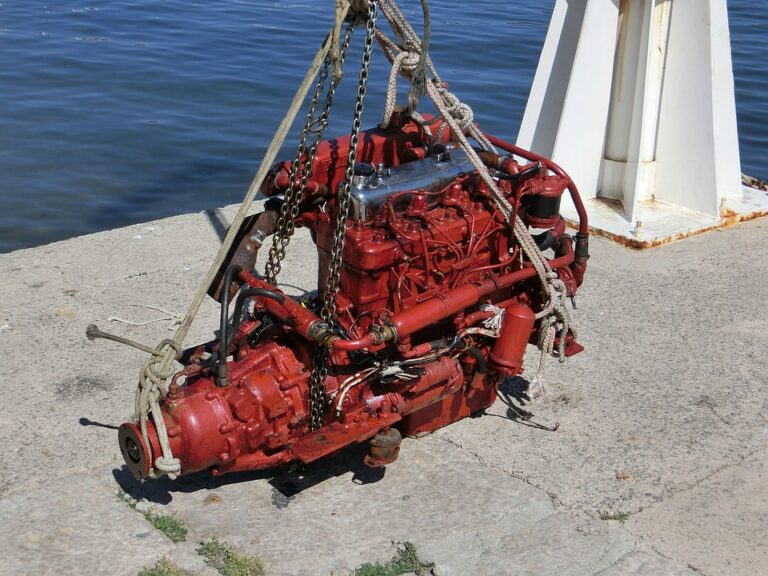The Art of Running Aground: Understanding Tides.
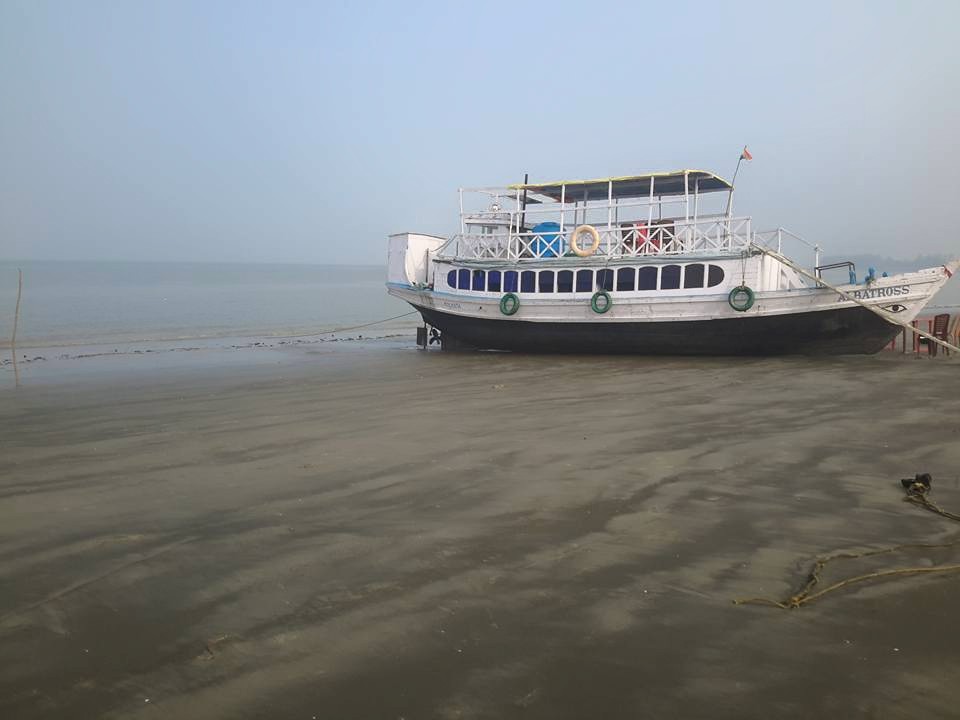
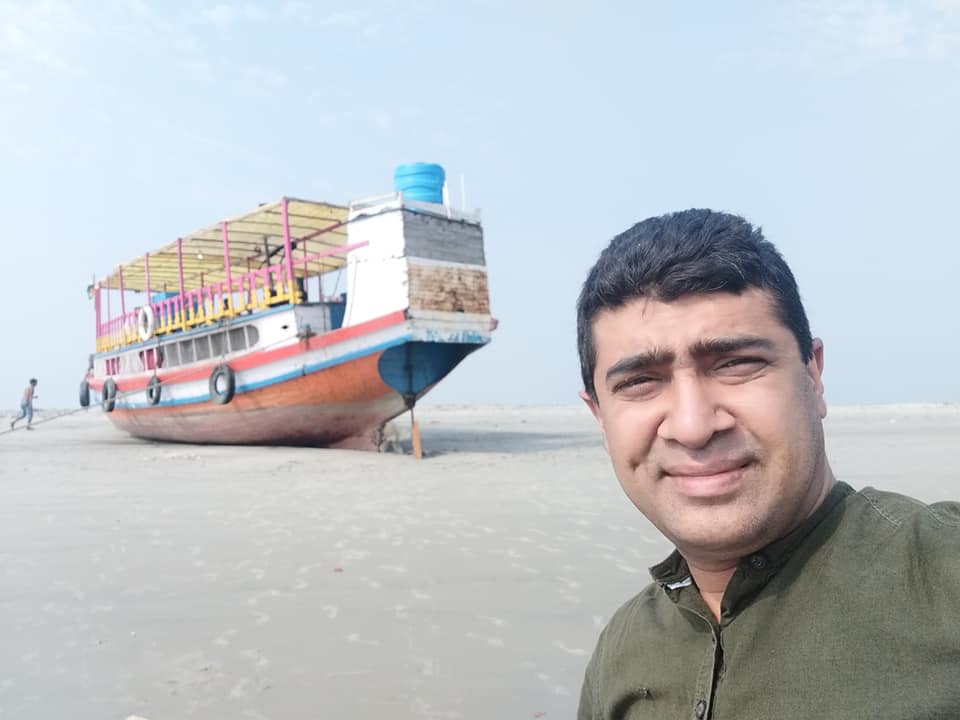
One of the greatest fears of sailors is running aground.
Running aground means a ship or a boat becomes stuck on the botton of a waterway, often in shallow water, due to the water being too shallow for it to continue floating and moving forward. It is a situation where the vessel has grounded and is unable to move.
Over the years me and my crew have become known, sometimes infamous, for running our boat aground on purpose in what is known as the roughest sea in the world ‘The Bay of Bengal’.
It all started in 2013 when we were scouting for new routes in the Sunderban deltas to conduct off beat boat adventure tour programmes.
One route in particular intrested us that takes us through the remote villages, dense mangrove forests and open sea, giving an experience of three different terrains and experience in one excursion. We later coined the name of this expedition ‘The Pirates Party Boat Tour’.
The remoteness of the route meant that we had to improvise to land on a specfic sandbar island that emerges in low tides and is almost submerged during high tides.
This led us to explore ‘the art of running aground’ in a safe and calulated manner.
The First Fright.
The first ‘acciddental’ running aground happened when we were executing a much thought after boat expedition under full moon. The idea was to sail in bright moonlight and camp on a sand bar island that appears only in low tide.
I was a novice sailor back then in 2014 and didn’t understand much the cycle and strength of tides under different moon conditions.
We had landed on this sand-bar island few times during the day time and I did some visual inspection of the tide levels left by the drift wood markings. All the calculations left me to believe that we would be within the safe parameters of the high tide during a full moon.
My long standing crew, who are as crazy as I am (that’s why they are a part of my crew as one has to be definitely abnormal to be able to be excited about the various off beat expeditions ;)), however on this occasion did warm me, ‘Sir, the island would go under waters in full moon for sure’ and left the final decision to sail completely on me.
Ofcourse I did decide to sail and did we? It was like a scene out of a Harry Potter Movie. Sailing under the full moon misty night shrouded in fog. It was like sailing through the clouds. I have no idea how the crew managed to visually navigate through our three and a half hours sail to the outer sea to reach the sand bank island.
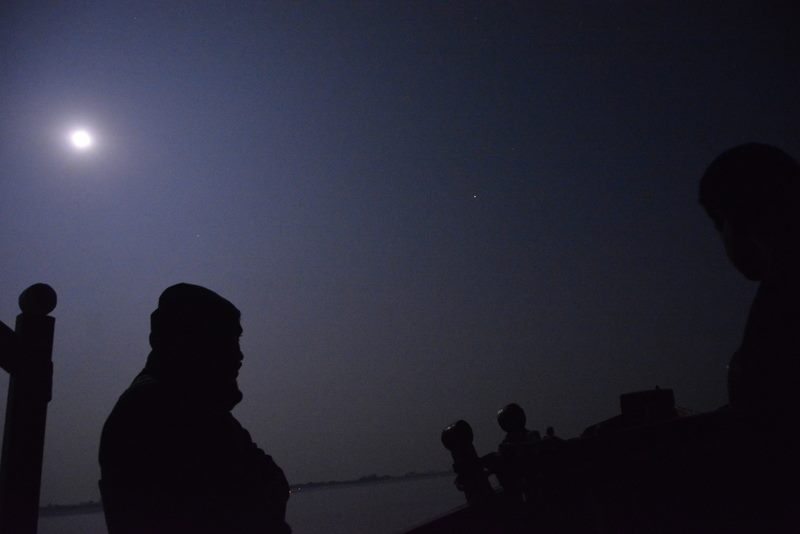
Reaching the island was one challenge, disembarking on the sand bank island on the trecheous high tide was another. We did this by first finding the ‘reverse ox-bow’ side of the dunes which has a lesser impact than the front side, which receives the waves head on. Following the tail end of the tide we were able to drop the stern anchor first before securing a good position to drop the second bow anchor. This held our boat position in one place inspite of the fluctuating tide gushes. We were able to embark on the island through the wooden step ladder, timing our descent inbetween the crashing waves.
It was a little fright for me to see that the high tide did go well beyond my last gauged tide mark that I had mapped a couple of days before on the island. However, we were lucky enough that the tides stopped rising in time leaving just an enough ground for us to camp. We managed to take a picture of us in all this chaos that sets us a constant reminder of our endavour and how close were were to a misadventure situation.
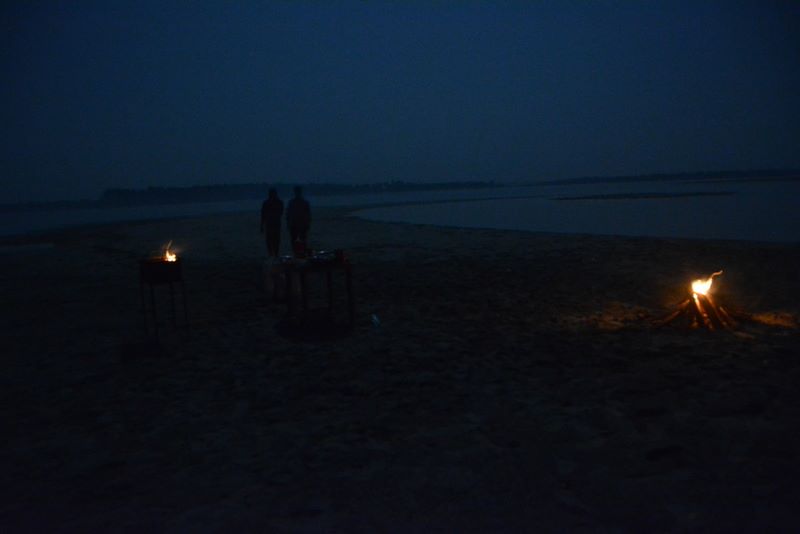
From that incident we did many countless tours to the island running aground on purpose. We had learnt to time our arrival on a receding half tide mark and back track all milestones and departures based on that.
Few times we missed the timing altogether and the consequences of that was we did not get ourselves picked up by the following days tides (who’s strength is lesser than the night’s tides).
We took many boat tours and this route. The tour soon reached top 10 things to do on trip advisor and you can still find the exhilerating customer’s tenstimonies listed under Crossindia Adventures.
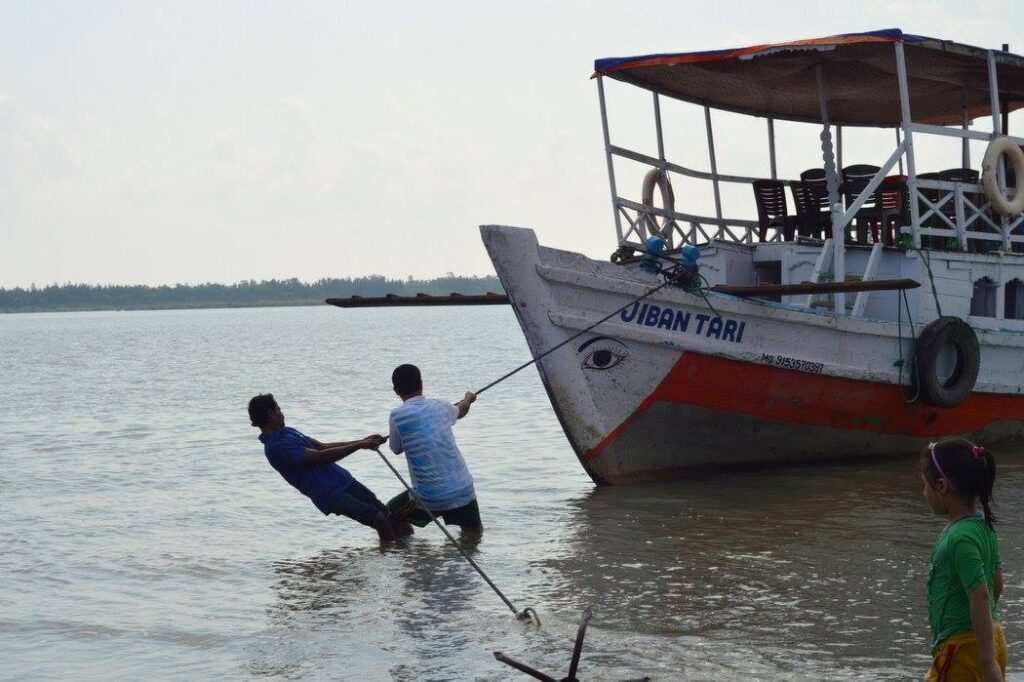
Playing with tides and running aground was fun but also made us study them more and respect mother nature as we found ourselves cuddled amidst the power and mercy of the waves and winds.
Tides are one of nature’s most rhythmic and mesmerizing phenomena. From the quiet ebb of water on a secluded beach to the dramatic rise of the sea in bustling harbors, tides have fascinated humankind for centuries. They play a crucial role in coastal ecosystems, influence marine life, affect maritime activities, and even shape entire cultures.
About Tides
Tides are the periodic rise and fall of sea levels caused primarily by the gravitational interactions between the Earth, the Moon, and the Sun. They are most noticeable along coastlines, where the changes in sea level can significantly alter the landscape every few hours.
Though tides may seem like simple water movement, they are part of a complex planetary system that reveals the interconnectedness of Earth’s natural forces.
The Science Behind Tides
Tides are caused by the gravitational pull exerted by the Moon and the Sun on the Earth’s oceans. The Moon plays the most significant role due to its proximity. As the Moon orbits the Earth, its gravity pulls on the water, creating a bulge — this is what we perceive as high tide. A second, opposing bulge forms on the opposite side of the Earth due to the centrifugal force of the Earth-Moon system.
The Earth’s rotation causes different areas to pass through these bulges, resulting in the regular pattern of rising and falling tides — typically two high tides and two low tides each day.
Types of Tides
There are several classifications of tides based on their patterns:
- Diurnal Tides: One high and one low tide per day.
- Semidiurnal Tides: Two high and two low tides of roughly equal height per day.
- Mixed Tides: Two highs and two lows, but with varying heights.
The type of tide experienced in a location depends on geographical and oceanographic factors.
The Lunar and Solar Influence
The Moon’s gravitational force is the primary driver of tides, but the Sun also plays a role. Although it is much farther away than the Moon, the Sun’s massive size means its gravitational pull still affects tides.
When the Sun, Moon, and Earth align (during full moon and new moon), their gravitational forces combine, leading to more extreme tides. When they are at right angles (first and third quarter moons), their effects partially cancel each other out.
Spring Tides and Neap Tides
- Spring Tides: These occur during new and full moons. The gravitational forces of the Moon and Sun combine to produce higher high tides and lower low tides.
- Neap Tides: These happen during the first and third quarter moons. The Sun and Moon are at right angles to Earth, leading to less pronounced tides.
Despite their names, spring tides have nothing to do with the season and occur twice each lunar month.
Tidal Ranges
Tidal range is the vertical difference between the high tide and the low tide. This can vary significantly across different coastal regions:
- Micromareal: Less than 2 meters.
- Mesomareal: 2 to 4 meters.
- Macromareal: More than 4 meters.
Some of the highest tidal ranges in the world are found in the Bay of Fundy (Canada), Mont Saint-Michel (France), and the Sundarbans (India-Bangladesh delta), where tidal shifts dramatically alter the landscape.
Tidal Currents and Bores
Tidal currents are the horizontal flow of water accompanying the rise and fall of the tide. They are strongest in narrow passages like straits and estuaries.
- Flood Tide: When the tide is rising and water flows inland.
- Ebb Tide: When the tide is receding and water flows back out to sea.
In some places, this movement creates tidal bores — powerful surges of water that travel upriver against the current. Notable tidal bores include the Qiantang River bore in China and the Hoogly River bore in India.
How Tides Affect Marine and Coastal Life
Tides play a vital role in maintaining healthy marine ecosystems. Intertidal zones, the area between high and low tides, are rich with biodiversity. Organisms in these areas are uniquely adapted to cope with fluctuating water levels, salinity, and exposure.
Tides influence spawning cycles, feeding behaviors, and migration patterns of marine life such as crabs, fish, and even birds. For example, horseshoe crabs time their egg-laying with spring tides for maximum survival chances.
Tides and Human Activities
Tides impact numerous human activities:
- Fishing and Aquaculture: Tides influence where and when to fish. Fishers often plan around tidal schedules.
- Navigation and Shipping: High tides allow vessels to navigate shallow waters, dock safely, and unload cargo.
- Recreation: Beachgoers, surfers, and sailors all monitor tides for safety and optimal conditions.
- Energy Production: Tidal energy is a growing renewable energy source, using underwater turbines or tidal barrages.
Understanding tides is essential for communities living near the sea and those relying on coastal resources.
Understanding Tide Tables
Tide tables provide predictions for high and low tide times and heights at specific locations. These are calculated using astronomical data and historical observations.
A typical tide table entry includes:
- Date
- Time of high and low tides
- Heights of the tides
- Phase of the Moon
Apps and websites now make tide information readily accessible to sailors, fishers, and travelers.Traditional and Cultural Knowledge of Tides
Long before modern science, coastal communities developed deep knowledge of tides through observation. Indigenous cultures, fishermen, and sailors passed this wisdom down through generations.
In India’s coastal Sundarbans, local fishers time their journeys with lunar phases and tidal shifts, avoiding treacherous low tides that reveal sandbanks. Polynesian navigators used tide and wave patterns to travel vast ocean distances.
Tides in History and Navigation
Tides have played a significant role in history:
- The Norman conquest of England in 1066 involved careful timing of tides for the crossing of the English Channel.
- In World War II, Allied forces relied on specific tidal conditions for the D-Day landings in Normandy.
Tides have always been critical in maritime navigation, shaping routes, port construction, and naval warfare strategies.
Climate Change and the Future of Tides
Climate change is already affecting tides in subtle and significant ways:
- Rising Sea Levels: Increasing sea levels alter the baseline for tides, leading to more frequent coastal flooding during high tides, known as “nuisance flooding.”
- Changing Weather Patterns: Storm surges combined with high tides, known as “king tides,” can lead to devastating floods.
Monitoring these changes is essential for coastal planning and adaptation efforts.
Tides in Mythology and Literature
Throughout history, tides have inspired myths, poetry, and stories:
- In Norse mythology, the tide was explained as the pulling of a giantess’ cauldron.
- Shakespeare referenced tides in Julius Caesar: “There is a tide in the affairs of men, which taken at the flood, leads on to fortune.”
- In Indian folklore, the Moon’s control over water was part of lunar deification and storytelling.
Tides evoke deep metaphors for change, cycles, and inevitability in literature and philosophy.
Tides are more than a curious rise and fall of the sea. They are the heartbeat of our planet’s oceans, shaped by celestial mechanics and influencing life on Earth in countless ways. Understanding tides is key not just for sailors and scientists, but for anyone who finds themselves drawn to the shore.
Whether you’re building a homestay by a tidal river, navigating a boat, exploring a beach, or simply watching the waves roll in, remember that tides are a reminder of the rhythms that govern our natural world — steady, powerful, and timeless.
